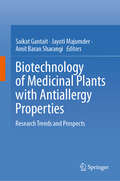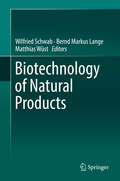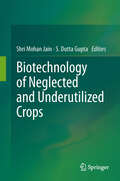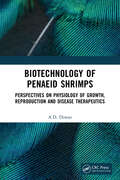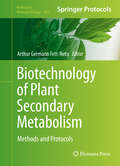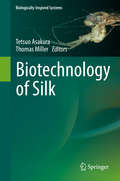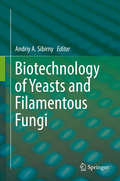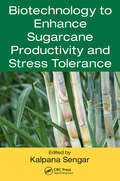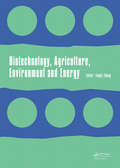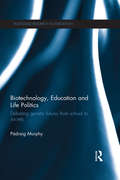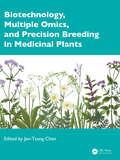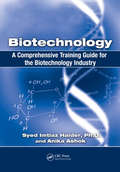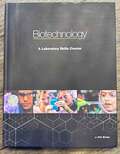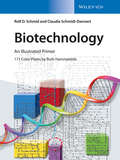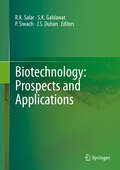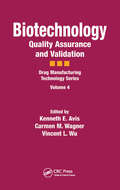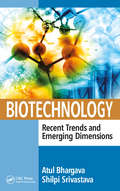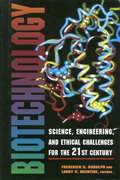- Table View
- List View
Biotechnology of Medicinal Plants with Antiallergy Properties: Research Trends and Prospects
by Amit Baran Sharangi Saikat Gantait Jayoti MajumderThis book comprehensively covers critically investigated information on medicinal plants prioritized for their anti-allergy properties. It offers insights into strategies related to the distribution, mechanism of action, and assessment of antiallergic medicinal plants, and also delves into crucial aspects of modern biotechnological tools, addressing their implementation challenges, presenting innovative approaches through case studies, and exploring opportunities for nanotechnologies. These elaborated discussions aim to raise awareness and bridge the gap between human health and the biodiversity of antiallergic medicinal plants. As the book navigates the uncertainties of plant-based medicines in the post-COVID-19 era, it provides real-world applications showcasing the specific utility of medicinal plants through advanced biotechnological insights. This book covers several medicinal plants associated with antiallergy, exploring their modes of action, available secondary metabolites,and estimation methods. It also emphasizes all modern biotechnological interventions aimed at propagating, multiplying, and conserving this unique treasure trove of medicinal plants. The World Health Organization estimated that 80% of the populations of developing countries rely on traditional medicines, mostly plant drugs, for their primary health care needs. Increasing demand in both developing and developed countries resulted in the expanding trade of medicinal plants and has serious implications for the survival of several plant species, with many under threat of becoming extinct. This book describes various approaches to conserving these genetic resources. It discusses the whole spectrum of biotechnological tools from micro-propagation for large-scale multiplication and cell-culture techniques to the biosynthesis and enhancement of pharmaceutical compounds in plants. It also discusses the genetic transformation as well as short- to long-term conservation of plant genetic resources via synthetic seed production and cryopreservation, respectively. This reference book is useful for researchers in the pharmaceutical and biotechnological industries, medicinal chemists, biochemists, botanists, molecular biologists, academicians, students as well as allergic patients, traditional medicine practitioners, scientists in medicinal and aromatic plants, and other traditional medical practitioners.
Biotechnology of Natural Products
by Wilfried Schwab Bernd Markus Lange Matthias WüstThis text comprehensively covers the analysis, enzymology, physiology and genetics of valuable natural products used in the food industry that are attractive targets for biotechnological production. The focus is on the recent advances made to achieve this goal. This unique work is the first book to focus on biotechnological production of important natural products in food additives, fragrances and flavorings, vitamins and other bioactive compounds in food. The chapters offer a deep insight into modern research and the development of low molecular weight natural products. Biotechnology of Natural Products covers products in the Phenolic, Terpenoid, Vitamin and Alkaloid categories, providing a full overview of the biotechnology of food additives and other low molecular weight natural products. Gene clustering and the evolution of pathways are covered, as well as future perspectives on the topic. Due to limited oil resources and increasing consumer demand for naturalness, bioprocesses are increasingly needed to meet these requirements. Novel sophisticated technologies have facilitated the elucidation of new chemical molecules, their biosynthetic pathways and biological functions. This book provides researchers with a full overview of the technologies and processes involved in the biotechnology of natural products.
Biotechnology of Neglected and Underutilized Crops
by Shri Mohan Jain S. Dutta GuptaThis important reference is the first comprehensive resource worldwide that reflects research achievements in neglected and underutilized crop biotechnology, documenting research events during the last three decades, current status, and future outlook. This book has 16 chapters divided into 4 sections. Section 1 has three chapters dealing with Chenopodium as a potential food source, thin cell layer technology in micropropagation of Jatropha, and Panax vietnamensis. Section 2 deals with molecular biology and physiology of Haberlea rhodopensis, cell trait prediction in vitro and in vivo of legumes, and application of TILLING in orphan crops. Section 3 has five chapters on biotechnology of neglected oil crops, Quinoa, Erucia sativa, Stylosanthes, and Miscanthus. And Section 4 contains five chapters mainly on genetic transformation of Safflower, Jatropha, Bael, and Taro. This section also includes a chapter on genetic engineering of Mangroves.
Biotechnology of Penaeid Shrimps: Perspectives on Physiology of Growth, Reproduction and Disease Therapeutics
by A.D. DiwanThe main objective of this book is to collect comprehensive information on various aspects of physiology and biotechnology focusing mainly on reproduction, growth, disease control and therapeutics of penaeid shrimps. The book covers fundamental aspects and few applied aspects of biotechnology concerning basic genomics and proteomics, reproduction, growth and disease control and therapeutics of shrimp. This information will be quite useful not only to the aqua-farmers/mariculture experts of the shrimp industry to augment quality shrimp production in captive condition but also to the faculties and students working in different organizations involved in teaching and research activities in shrimp biotechnology.Note: T&F does not sell or distribute the Hardback in India, Pakistan, Nepal, Bhutan, Bangladesh and Sri Lanka.
Biotechnology of Plant Secondary Metabolism: Methods and Protocols (Methods in Molecular Biology #1405)
by Arthur Germano Fett-NetoThis volume describes up-to-date techniques for improved production of secondary metabolites of economic interest using field and laboratory methods. Biotechnology of Plant Secondary Metabolism: Methods and Protocols explores different secondary metabolite classes, whole-plant and cell/organ culture systems, and environmental and genetic transformation-based modulation of biochemical pathways. Special focus is given to cell and tissue specific metabolism, metabolite transport, microRNA-based technology, heterologous systems expression of enzymes and pathways leading to products of interest, as well as applications using both model and non-model plant species. Written in the highly successful Methods in Molecular Biology series format, chapters include introductions to their respective topics, lists of the necessary materials and reagents, step-by-step, readily reproducible laboratory protocols, and tips on troubleshooting and avoiding known pitfalls. Practical and cutting-edge, Biotechnology of Plant Secondary Metabolism: Methods and Protocols is a great resource for scientists of interdisciplinary fields--plant science, plant physiology, pharmacy, molecular biology, biochemistry, bioengineering, and forestry--in reaching their goals of producing plant biochemicals in a sustainable and efficient manner, while minimizing impacts to the environment and providing the required quantities of these commodities to industry.
Biotechnology of Plasma Proteins (Protein Science)
by Roger L. LundbladThe fractionation of human blood plasma can be considered to be a mature industry, with the basic technology, alcohol fractionation, dating back at least to the 1940s. Many of the products described in the current work have been approved biologics since the 1950s. The information gathered from the development of plasma proteins has proved vital to
Biotechnology of Silk (Biologically-Inspired Systems #5)
by Tetsuo Asakura Thomas MillerThis book is a snapshot of the current state of the art of research and development on the properties and characteristics of silk and their use in medicine and industry. The field encompasses backyard silk production from ancient time to industrial methods in the modern era and includes an example of efforts to maintain silk production on Madagascar. Once revered as worth its weight in gold, silk has captured the imagination from its mythical origins onwards. The latest methods in molecular biology have opened new descriptions of the underlying properties of silk. Advances in technological innovation have created silk production by microbes as the latest breakthrough in the saga of silk research and development. The application of silk to biomaterials is now very active on the basis of excellent properties of silks including recombinant silks for biomaterials and the accumulated structural information.
Biotechnology of Yeasts and Filamentous Fungi
by Andriy A. SibirnyThis book provides a comprehensive overview on biotechnological applications of unicellular and multicellular fungi in a variety of industrial branches. Targeted genetic and metabolic engineering of fungi allows production of native and transgenic enzymes and proteins in industrial scales. Those most prominently find application in biorefineries for the production of value-added chemicals and biofuels, in the pharmaceutical industry as well as in biomedicine. Each chapter is dedicated to applications and potential beneficial use of particular strains of yeasts and filamentous fungi and their produced biomolecules. The book targets researchers from both academia and industry and graduate students working in microbial biotechnology.
Biotechnology of Yeasts and Filamentous Fungi (Grand Challenges in Biology and Biotechnology)
by Andriy A. SibirnyThis updated and extended second edition provides a comprehensive overview on biotechnological applications of unicellular and multicellular fungi in a variety of industrial settings. Each chapter is dedicated to applications and potential beneficial use of particular strains of yeasts and filamentous fungi and their produced biomolecules, ranging from glycerol to carotenoids. This new edition further includes a brand-new chapter on lactic acid production in yeast. Targeted genetic and metabolic engineering of fungi allows production of native and transgenic enzymes and proteins in industrial scales. Those most prominently find application in biorefineries for the production of value-added chemicals and biofuels, in the pharmaceutical industry as well as in biomedicine. This volume addresses researchers from both academia and industry, and graduate students working in microbial biotechnology.
Biotechnology to Enhance Sugarcane Productivity and Stress Tolerance
by Kalpana SengarSugarcane is the most important plant source for sugar and alcohol production and is cultivated in more than 80 countries in tropical and subtropical areas. However, environmental factors negatively influence its yield and jeopardize the prospect to meet the increasing demand for sugar, other sugarcane derived by products and bioethanol. The development of stress tolerant plants is fundamental for the maintenance and increase of crop yields. Biotechnology to Enhance Sugarcane Productivity and Stress Tolerance provides a comprehensive account of both theoretical and practical aspects of sugarcane production. It contains extensive coverage of genome mapping and molecular breeding in sugarcane and presents the status of the elucidation and improvement of plant genomes of economic interest. Through 14 chapters written by eminent scientists with global influence, this book examines various methods for sugarcane improvement through biotechnology. The book focuses on genetic and physical mapping, positioning, cloning, and monitoring of desirable genes using biotechnological approaches for high sugarcane productivity and the development of stress tolerance. Additional information includes the bioengineering of sugarcane, procedures to boost productivity, genetics and assessments for resistance to drought and salinity, genetics for high yields, and various topics of research on sugarcane genetics. It serves as a detailed reference source for cane growers, sugar and sugarcane technologists, students, and professors.
Biotechnology, Agriculture, Environment and Energy: Proceedings of the 2014 International Conference on Biotechnology, Agriculture, Environment and Energy (ICBAEE 2014), May 22-23, 2014, Beijing, China.
by Fangli ZhengThe 2014 International Conference on Biotechnology, Agriculture, Environment and Energy (ICBAEE 2014) was held May 22-23, 2014 in Beijing, China. The objective of ICBAEE 2014 was to provide a platform for researchers, engineers, academics as well as industry professionals from all over the world to present their research results and development act
Biotechnology, Education and Life Politics: Debating genetic futures from school to society (Routledge Research in Education)
by Pádraig MurphyWhat should individuals and society do when genetic screening becomes widely available and with its impact on current and future generations still uncertain? How can our education systems around the world respond to these developments? Reproductive and genetic technologies (RGTs) are increasingly controversial and political. We are entering an era where we can design future humans, firstly, by genetic screening of "undesirable" traits or indeed embryos, but perhaps later by more radical genetic engineering. This has a profound effect on what we see as normal, acceptable and responsible. This book argues that these urgent and biopolitical issues should be central to how biology is taught as a subject. Debate about life itself has always been at the forefront of connected molecular, genetic and social/personal identity levels, and each of these levels requires processes of communication and debate, what Anthony Giddens called in passing life politics. In this book Pádraig Murphy opens the term up, with examples from field research in schools, student responses to educational films exploring the future of RGTs, and science studies of strategic biotechnology and the lab practices of genetic screening. Life political debate is thoroughly examined and is identified as a way of connecting mainstream education of biology with future generations. Biotechnology, Education and Life Politics will appeal to post-graduates and academics involved with science education, science communication, communication studies and the sociology of education.
Biotechnology, Human Nature, and Christian Ethics (New Studies in Christian Ethics)
by Gerald McKennyIn public debates over biotechnology, theologians, philosophers, and political theorists have proposed that biotechnology could have significant implications for human nature. They argue that ethical evaluations of biotechnologies that might affect human nature must take these implications into account. In this book, Gerald McKenny examines these important yet controversial arguments, which have in turn been criticized by many moral philosophers and professional bioethicists. He argues that Christian ethics is, in principle, committed to some version of the claim that human nature has normative status in relation to biotechnology. Showing how both criticisms and defences of this claim have often been facile, he identifies, develops, and critically evaluates three versions of the claim, and contributes a fourth, distinctively Christian version to the debate. Focusing on Christian ethics in conversation with secular ethics, McKenny's book is the first thorough analysis of a controversial contemporary issue.
Biotechnology, Multiple Omics, and Precision Breeding in Medicinal Plants
by Jen-Tsung ChenBiotechnology, Multiple Omics, and Precision Breeding in Medicinal Plants explores the various methods for advancing medicinal plant research. It covers a wide range of approaches, including integrated and advanced plant biotechnology, mutagenesis, nanotechnology, genome-wide association studies, multiple omics tools, and high-throughput technologies. The book highlights the significant impact of combining pan-genomics with metabolomics in medicinal plant research, particularly in understanding how genetic diversity influences the profiles of secondary metabolites and the therapeutic potential of these plants.FEATURES: Explores ways to improve the production of secondary metabolites and bioactive compounds in key medicinal plants Features information on bioinformatics, artificial intelligence models, molecular markers, and genome editing techniques such as CRISPR-assisted precision breeding Promotes specific prebiotic formulas to ward off adverse effects of antibiotics Covers information on epigenetic regulation in boosting secondary metabolite production and the use of speed breeding combined with high-throughput technologies Proposing a multitude of technologies and methodologies in plant biotechnology with focus on enhancing the production of secondary metabolites and bioactive compounds from medicinal plants, this book is an ideal resource for researchers and academia in plant sciences/breeding, agriculture, and horticulture industries.
Biotechnology: A Comprehensive Training Guide for the Biotechnology Industry
by Syed Imtiaz Haider Anika AshtokAll manufacturing companies face the daunting task of designing an employee training matrix that meets the gamut of national and international regulatory standards. Answering the call for a one-stop training resource that focuses exclusively on this multi-faceted, high-tech industry, Biotechnology: A Comprehensive Training Guide for the Biotechnology Industry provides ready-to-implement training templates that save time and expense without cutting corners on critical elements.Downloadable Resources: Why Reinvent the Wheel?This complete, single-source reference contains 28 complete biotechnology courses and a customizable downloadable resources with hands-on training tools. The book also provides time-saving information on how to orient employees involved in writing and executing batch manufacturing and in-process control documents.Key Benefits: Contains adaptable training text, test summaries and papers, test answers, and certificates of completion Streamlines the training process, maximizing efficiency Boosts the marketing edge over competitors This valuable training tool presents step-by-step guidance for optimizing research and development expenditures, avoiding marketing delays, gaining a competitive advantage, reducing product development failures, developing skilled manpower, and maintaining local and international regulatory compliance.
Biotechnology: A Laboratory Skills Course
by J. Kirk BrownA general survey of knowledge and techniques needed to function in a biotechnology lab.
Biotechnology: A Laboratory Skills Course
by J. Kirk BrownThis laboratory textbook blends theory with hands-on laboratory activities and real-world applications for your biotechnology course, and it incorporates Bio-Rad Explorer kits for easy implementation. This Develops key skills with multiple activities. Encourages students to consider the implications of biotechnology with bioethics case studies. Broadens occupational awareness with profiles of careers in biotech. Lets students answer a research question using independent research. The teacher supplement provides a thorough background on preparation, setup, results analysis, and assessment. It also provides guidance on how to implement and build a biotechnology course.
Biotechnology: An Illustrated Primer
by Rolf D. Schmid Ruth HammelehleNow presented in large format, the new Schmid is the ideal primer in biotechnology. The two-page layout with one page being a full color figure and the opposite page being explanatory text is the ideal combination between rapid visual-based learning with in depth information.
Biotechnology: Prospects And Applications
by R. K. Salar S. K. Gahlawat P. Siwach J. S. DuhanBiotechnology: Prospects and Applications covers the review of recent developments in biotechnology and international authorship presents global issues that help in our understanding of the role of biotechnology in solving important scientific and societal problems for the benefit of mankind and environment. A balanced coverage of basic molecular biology and practical applications, relevant examples, colored illustrations, and contemporary applications of biotechnology provide students and researchers with the tools and basic knowledge of biotechnology. In our effort to introduce students and researchers to cutting edge techniques and applications of biotechnology, we dedicated specific chapters to such emerging areas of biotechnology as Emerging Dynamics of Brassinosteroids Research, Third generation green energy, Bioremediation, Metal Organic Frameworks: New smart materials for biological application, Bioherbicides, Biosensors, Fetal Mesenchymal Stem Cells and Animal forensics. Biotechnology: Prospects and Applications will be highly useful for students, teachers and researchers in all disciplines of life sciences, agricultural sciences, medicine, and biotechnology in universities, research stations and biotechnology companies. The book features broader aspects of the role of biotechnology in human endeavor. It also presents an overview of prospects and applications while emphasizing modern, cutting-edge, and emerging areas of biotechnology. Further, it provides the readers with a comprehensive knowledge of topics in food and agricultural biotechnology, microbial biotechnology, environmental biotechnology and animal biotechnology. The chapters have been written with special reference to the latest developments in above broader areas of biotechnology that impact the biotechnology industry. A list of references at the end of each chapter is provided for the readers to learn more about a particular topic. Typically, these references include basic research, research papers, review articles and articles from the popular literature.
Biotechnology: Quality Assurance and Validation
by Kenneth E. Avis Carmen M. Wagner Vincent L. WuBiotechnology: Quality Assurance and Validation provides a practical, detailed discussion of what issues Quality Assurance and Quality Control need to identify for effective control in the preparation of biotechnology products. The book presents a series of topics that define some of the unique challenges facing biotechnology companies in producing biopharmaceutical products. The topics selected address quality and validation issues, starting with the cryopreservation of cell lines through the filling and finishing of the product. It includes a validation guide, a clear presentation of how to use filtration effectively, a synoptic view of cleaning procedures, and much more.
Biotechnology: Recent Trends And Emerging Dimensions
by Atul Bhargava and Shilpi SrivastavaBiotechnology is a multidisciplinary field encompassing microbiology, bichemistry, genetics, molecular biology, chemistry, immunology, cell and tissue culture physiology. This book describes the recent developments in these areas. Current research topics such as Quorum sensing, Integrons, Phytomining are discussed, which would serve as an excellent reference work for both academicians and researchers in the field.
Biotechnology: Science for the New Millennium
by Ellyn DaughertyThis complete program teaches the concepts and hands-on lab procedures required for entry-level careers in the rapidly growing biotechnology industry. The textbook and lab manual can be used together or separately, depending on the desired course format.
Biotechnology: Science for the New Millennium
by Ellyn DaughertyThe new edition of Biotechnology: Science for the New Millennium is the perfect textbook and lab manual combination program for your classroom! Designed for introductory courses, this complete program teaches the concepts and hands-on lab procedures required for entry-level careers in the rapidly growing biotechnology industry. The textbook and lab manual can be used together or separately, depending on the desired course format.
Biotechnology: Science, Engineering, And Ethical Challenges For The Twenty-First Century
by Frederick B. Rudolph Larry V. McintireBiotechnology-the manipulation of the basic building blocks of life-is rapidly advancing in laboratories around the world. It has become routine to refer to DNA fingerprints and genetically engineered foods.Yet the "how to" of biotechnology is only the beginning. For every report of new therapies or better ways to produce food, there is a Jurassic Park scenario to remind us of the potential pitfalls.Biotechnology raises serious issues for scientists and nonscientists alike: Who will decide what is safe? Who will have access to our personal genetic information? What are the risks when advanced science becomes big business?In Biotechnology, experts from science, law, industry, and government explore a cross-section of emerging issues. This book offers straightforward explanations of basic science and provides insight into the serious social questions raised by these findings.The discussions explore five key areas: The state of the art in biotechnology-including an overview of the genetic revolution, the development of recombinant DNA technology, and the possibilities for applying the new techniques. Potential benefits to medicine and the environment-including gene therapy, the emerging area of tissue engineering and biomaterials, and the development of therapeutic proteins. Issues in technology transfer-focusing on the sometimes controversial relationship between university research centers and industry. Ethics, behavior, and values-exploring the ethical issues that surround basic research and applications of new technology, with a discussion of scientific misconduct and a penetrating look at the social impact of genetic discoveries. Government's role-including a comparison of U.S., European, and Japanese policies on pharmaceutical and biotechnology development. Biotechnology is here to stay, and this volume adds immeasurably to understanding its multiple aspects and far-reaching implications. This book will be of interest to scientists and industry leaders involved in biotechnology issues-and it will be welcomed by the concerned lay reader.Frederick B. Rudolph, Ph.D., is a professor of biochemistry and cell biology at Rice University and is executive director of the Institute of Biosciences and Bioengineering.Larry V. McIntire, Ph.D., is the E. D. Butcher Professor of Chemical and Biomedical Engineering at Rice University and is chair of the Institute of Biosciences and Bioengineering.
